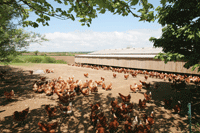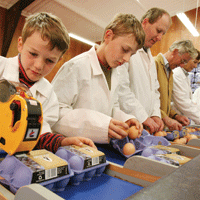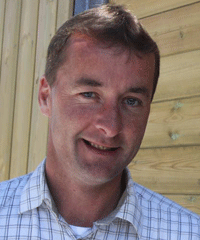Rearing your own pullets offers advantages

Good quality pullets are essential to the success of any laying flock, and a growing number of producers are seeking to take control of the rearing cycle. But pullet rearing is not easy, so how can you ensure your flocks are produced to the best possible standard?
Dave Welch, technical manager for Lohmann GB in the South West of England, says the key to pullet rearing is rigorous attention to detail. “The preparation of the house must be perfect, and your bio-security has to be spot on. It is a lot more work and responsibility to rear your own pullets, and you need to be aware of the risks if you want to take control of your whole production.”
Most farmers decide to rear their own pullets to reduce the threat of disease – home-reared birds tend to gain some immunity to the farm’s bugs. Producers are also in control of the pullets’ vaccination programme and environment, to give them the best entry into the laying house.
Housing
The first consideration is the housing, says Mr Welch. Producers can either convert existing barns or erect a new shed, but good insulation is essential. The shed should be easy to clean, and requires a decent water supply, electricity, heaters, fans and a feeding system.
“It should also not be located adjacent to the laying house because of the danger of transmitting disease from the older birds to the chicks.” Rearing units should also be arranged in a similar layout to the laying sheds, for a smoother transition from one house to the next.
Before housing the chicks, producers must thoroughly clean, disinfect and fumigate the shed, and pre-heat it around 24 hours before the chicks arrive. On the day of delivery the air temperature should be 30-33C, chicks should be placed around the feed and water pans and penned in the heated area for the first seven days.
Requirements
The air temperature should be lowered daily, according to the chicks’ requirements. “You have to look at the stock – observation of the stock is the most important thing,” says Mr Welch. The birds should be happily feeding and drinking down the middle of the shed, and usually heaters can be turned off altogether by eight weeks of age, except in very cold weather.
Typically, chicks should be fed a starter feed from one day old to three weeks, then a chick feed until 10 weeks, followed by a grower feed until transfer to the laying house at 15-18 weeks. However, birds should be weighed weekly and changes in ration made according to bodyweight gains.
Feed should be ad-lib initially, and then producers should build in a gap in the middle of the day, to follow the birds’ natural eating pattern once in lay, he adds.
Lighting is another important consideration. For the first three days lights should be on for 20 hours a day, allowing some darkness for resting time. Lighting regimes will be different for each target egg cycle, but typically, lighting will be reduced gradually to 10 hours a day at three weeks of age for birds destined for colony [enriched cage] systems, or six weeks of age for free range layers.
Challenges
One of the greatest challenges facing pullet rearers is disease, says Mr Welch. “In the first three weeks good bio-security is the most important thing. Go to the chicks before the layers, always wear clean clothes, and have disinfectant at the door.” Coccidiosis is the biggest threat, but is manageable with good bio-security and careful monitoring of bird health, he adds. “Work with your vet to develop a flock health plan and vaccination programme – get them involved with what you’re doing.”
Ideally, each batch of pullets should be as even in weight as possible – variations are usually caused by disease or poor management. “Address any problem as soon as you notice it – it is all about managing the birds to their best performance,” says Mr Welch. “And as with any pullets, weigh them weekly to ensure they are maintaining body weight before changing the lighting to induce the start of lay.”

CASE STUDY
RICHARD TONKS, CORNWALL
Richard Tonks has been rearing his own pullets at Ventonwyn Farm, Tregony, Cornwall, for the past five years. “We had had some rather variable flocks of pullets, and we were giving up keeping cows, and thought that the milking parlour would make a good shed for rearing,” he says.
When converting the milking parlour, Mr Tonks installed two removable walls so that the chicks can be given more space as they grow. “We only heat the middle section – it is so well insulated that two brooders heat the whole shed,” he says.
With four free-range laying houses – two of 4000 birds and two of 3000 birds, Mr Tonks rears his pullets on a 20-week cycle – 16 weeks of rearing and a four-week turnaround. With a few hundred extra chicks to cover potential mortality, he has developed a good market for point of lay pullets to take up surplus stock.
Although infectious bronchitis (IB) used to be a problem with some bought-in pullets, Mr Tonks has developed a simple vaccination programme for his own chicks, to encourage as much natural immunity as possible. “The idea is to get them used to all the bugs they’re likely to encounter in adult life.” He vaccinates for salmonella, IB, bursal disease, Newcastle disease and avian encephalomyelitis.
He treats for coccidiosis on a weekly basis from two to seven weeks, to encourage greater immunity, and also gives a five-in-one dead vaccine before moving the pullets to the laying sheds. “We are very bio-secure for the first month and after that we really want to acclimatise them to everything going – so we go in with dirty boots, and it seems to work reasonably well.”
Disease challenges are far fewer than before, and egg production is much steadier – although few flocks manage to peak at 90%, they seem to do well in later lay. Egg quality is also better, he adds. “We have had one bad lot of chicks, which is very annoying because you know you’re going to be struggling straight away.”
Generally, Mr Tonks reckons he saves 50-75p/bird by rearing his own, with costs more spread out than when buying in pullets. In future he wants to toughen the chicks up even more before turning them out onto the range. “One tends to mollycoddle them a bit too much, but they’re tougher than one thinks.”

CASE STUDY
TERRY GRANDFIELD, DEVON
Terry Grandfield started rearing his own organic pullets early last year, with a view to reducing the disease challenges in a highly populated poultry area. He keeps 6000 organic layers at Orchard Farm, Plymtree, Devon, and decided he wanted complete control over his birds’ vaccination programmes and rearing progress.
“We thought that if we reared on site we could reduce the disease challenges when the birds are coming into lay,” he says. “It seems to have worked quite well.”
Mr Grandfield converted an old cow shed into the rearing house and included raised slatted floors similar to the laying houses. He vaccinates for the common diseases, including the local infectious bronchitis strains, and has noticed a dramatic reduction in infection rates and recovery time. He catches, vaccinates and moves the pullets to the rearing house in just 30 minutes per batch, ensuring a stress-free transfer.
The chicks are reared under brooder lamps, with the rest of the shed kept fairly cool. This keeps the young pullets active, and they are allowed out onto the range from about 12 weeks. “They seem to be a lot healthier and hardier, with better feather cover,” says Mr Grandfield.
Most are moved to the laying house at 16 weeks, but the first crop were so strong that he moved them at 14 weeks. Now at 45 weeks, their egg production is above average so far. “It’s nice to be in full control of the whole system and have that sort of flexibility.”
Mr Grandfield reckons there is only a slight saving in rearing his own pullets. “I could probably buy in pullets as cheap, but I know that I’m getting the right pullet for my laying site and the better production and lower diseases are worth a lot to me.”
